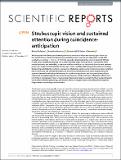Files in this item
Stroboscopic vision and sustained attention during coincidence-anticipation
Item metadata
| dc.contributor.author | Ballester, Rafael | |
| dc.contributor.author | Huertas, Florentino | |
| dc.contributor.author | Uji, Makoto | |
| dc.contributor.author | Bennett, Simon | |
| dc.date.accessioned | 2018-01-09T10:30:24Z | |
| dc.date.available | 2018-01-09T10:30:24Z | |
| dc.date.issued | 2017-12-20 | |
| dc.identifier | 252005727 | |
| dc.identifier | 079efcfd-0083-411b-8d78-db8f8bcc8950 | |
| dc.identifier | 85038635635 | |
| dc.identifier.citation | Ballester , R , Huertas , F , Uji , M & Bennett , S 2017 , ' Stroboscopic vision and sustained attention during coincidence-anticipation ' , Scientific Reports , vol. 7 , 17898 . https://doi.org/10.1038/s41598-017-18092-5 | en |
| dc.identifier.issn | 2045-2322 | |
| dc.identifier.other | ORCID: /0000-0002-9445-6353/work/40535304 | |
| dc.identifier.uri | https://hdl.handle.net/10023/12445 | |
| dc.description | This research was supported by a Spanish Ministerio de Educación y Cultura (https://sede.educacion.gob.es) predoctoral grant (FPU13-05605) to R.B and project research grants: Junta de Andalucia Proyecto de Excelencia (SEJ-6414), Ministerio de Economía y Competitividad (PSI2013-46385) to FH. | en |
| dc.description.abstract | We compared coincidence-anticipation performance in normal vision and stroboscopic vision as a function of time-on-task. Participants estimated the arrival time of a real object that moved with constant acceleration (−0.7, 0, +0.7 m/s2) in a pseudo-randomised order across 4 blocks of 30 trials in both vision conditions, received in a counter-balanced order. Participants (n = 20) became more errorful (accuracy and variability) in the normal vision condition as a function of time-on-task, whereas performance was maintained in the stroboscopic vision condition. We interpret these data as showing that participants failed to maintain coincidence-anticipation performance in the normal vision condition due to monotony and attentional underload. In contrast, the stroboscopic vision condition placed a greater demand on visual-spatial memory for motion extrapolation, and thus participants did not experience the typical vigilance decrement in performance. While short-term adaptation effects from practicing in stroboscopic vision are promising, future work needs to consider for how long participants can maintain effortful processing, and whether there are negative carry-over effects from cognitive fatigue when transferring to normal vision. | |
| dc.format.extent | 7 | |
| dc.format.extent | 1018776 | |
| dc.language.iso | eng | |
| dc.relation.ispartof | Scientific Reports | en |
| dc.subject | BF Psychology | en |
| dc.subject | NDAS | en |
| dc.subject.lcc | BF | en |
| dc.title | Stroboscopic vision and sustained attention during coincidence-anticipation | en |
| dc.type | Journal article | en |
| dc.contributor.institution | University of St Andrews. School of Psychology and Neuroscience | en |
| dc.identifier.doi | 10.1038/s41598-017-18092-5 | |
| dc.description.status | Peer reviewed | en |
This item appears in the following Collection(s)
Items in the St Andrews Research Repository are protected by copyright, with all rights reserved, unless otherwise indicated.

